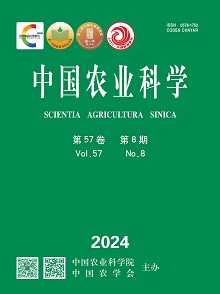【Background】 Food safety is key for ensuring national security. Rice is the staple food crop upon which people life depend. It is an important breeding target to improve its yield. Rice yield is composed of panicle number per plant, grain number per panicle and grain weight, among which grain weight relates closely to grain size and filling degree. However, these traits are controlled by multiple genes, and their genetic basis are complex. Chromosome segment substitution lines (CSSLs) can accurately dissect QTL for complex trait into a single Mendel’s factor, which is closely linked with the breeding work, so they are ideal materials for genetic research and breeding. 【Objective】 In the early stage, we fine-mapped a seed shattering gene SH6 using a rice chromosome segment substitution line Z481 carrying four substitution segments, However, there are still some significant differences in the panicle traits between Z481 and its recipient parent Nipponbare. It is important to understand how to distribute for these QTLs controlling panicle traits on 4 substitution segments of Z481 and then to dissect them into single segment substitution lines (SSSLs) for map-cloning of target QTL in theory meaning and for rice breeding by design in application value.【Method】 Here, the secondary F2 population constructed by crossing Nipponbare with Z481 was used to map QTL for these traits by mixed linear model (MLM) method in SAS9.3 statictic shoftware (P<0.05), and then by MAS method to develop SSSLs and dual-segment substitution lines (DSSLs) in F3 derived from 42 F2 indiviuals according to their genotypes and phynotypes. Finally, the additive effect and epistasis effect of QTL were analyzed using these SSSLs and DSSLs by ONE-WAY ANOVA,TWO-WAY ANOVA, LSD and Duncan’s multiple comparasion (P<0.05) in IBM SPSS Statistics 25.0.【Result】 12 QTLs controlling rice panicle traits are mapped from the secondary F2 population constructed by Nipponbare/Z481, and 11 single segment substitution lines (S1-S11) and 3 dual-segment substitution lines (D1-D3) with each corresponding single substitution segment are developed. Among them, 8 QTLs (qGL1, qGL3, qGL6, qG-W1, qGW3, qRLW1, qRLW3, qRLW6) can be verified by 11 SSSLs, indicating that these QTLs are genetically stable. In addition, 33 QTLs such as qGL1-2, qGL1-3, qGL3-2 etc. are only detected by 11 single segment substitution lines. Among them, 15 QTLs such as qNSB1-1 etc. might be novel QTLs identified in the study. Furthermore, the epistasis effect between non-allelic QTLs was analyzed by three DSSLs and corresponding SSSLs, the results showed that pyramid of different QTL produce various epistasis effect. For example, the pyramid of qGL3 (a=1.26) and qGL6-2(a=0.86) yield epistasis effect of -0.77, according to the genetic model of DSSL, D2 with the genetic effect of 1.35 produce longer grain length than any of two SSSLs with qGL3 or qGL6-2; the pyramid of qGWT3-2 (a=3.18) and qGWT6-2 (a=3.39) produce epistasis effect of -5.46, making the 1000-grain weight of D2 significantly smaller than that of the corresponding SSSLs due to its genetic effect of 1.11.【Conclusion】 In total 45 QTLs for rice panicle traits are deteted on the 4 substitution segments of Z481 and then further dissected into 11 secondary SSSLs. SSSL have higher efficiency for QTL detection than the F2 population. The additive effect and epistasis effect of these QTLs detected by SSSL and DSSL are necessary for breeders to predict the phenotype of the designed genotype according to these genetic informations and then to screen favorable SSSLs to breed by design.











